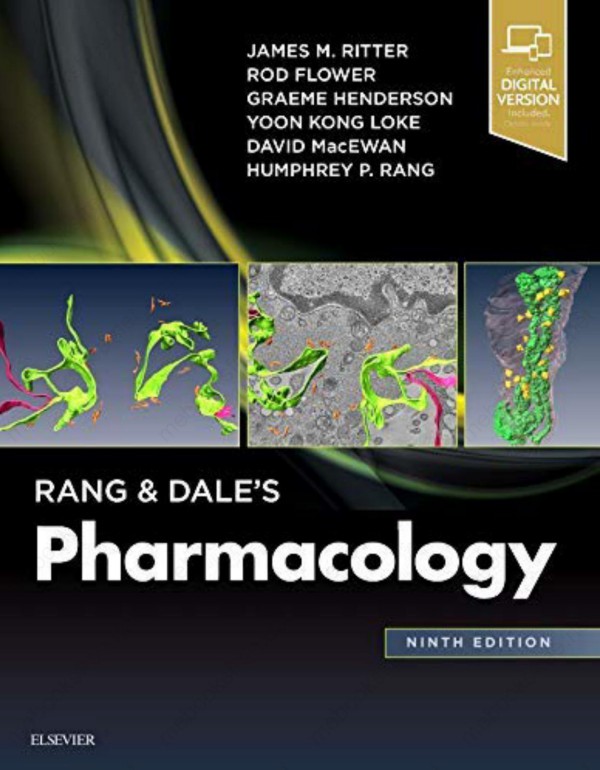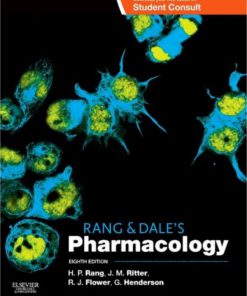Rang and Dale’s Pharmacology 9th edition by James Ritter, Rod Flower, Graeme Henderson, Yoon Kong Loke, David MacEwan, Humphrey Rang ISBN 0702074489 978-0702074486
$50.00 Original price was: $50.00.$25.00Current price is: $25.00.
Authors:James Ritter, Rod Flower, Graeme Henderson, Yoon Kong Loke, David MacEwan, Humphrey Rang – , Series:Pharmacology [52] , Author sort:James Ritter, Rod Flower, Graeme Henderson, Yoon Kong Loke, David MacEwan, Humphrey Rang – , Ids:DOI , Languages:Languages:eng , Published:Published:Jan 2019 , Publisher:Elsevier , Comments:Comments:Rang & Dale’s Pharmacology, Ninth Edition (2020) i-iii. doi:10.1016/B978-0-7020-7448-6.00064-0
Rang & Dale’s Pharmacology 9th edition by James Ritter, Rod Flower, Graeme Henderson, Yoon Kong Loke, David MacEwan, Humphrey Rang – Ebook PDF Instant Download/Delivery. 0702074489 978-0702074486
Full download Rang & Dale’s Pharmacology 9th edition after payment

Product details:
ISBN 10: 0702074489
ISBN 13: 978-0702074486
Author: James Ritter, Rod Flower, Graeme Henderson, Yoon Kong Loke, David MacEwan, Humphrey Rang
Comprehensive yet easy to use, Rang and Dale’s Pharmacology has been providing core basic and clinical science information to students and healthcare practitioners worldwide for more than 25 years. The fully revised 9th Edition keeps you up to date with all that’s new in the field, including new and emerging drugs and recent studies. From cover to cover, you’ll progressively increase your knowledge of all relevant aspects of pharmacology, from a molecular understanding of receptors and drug actions through clinical uses of key groups of drugs.
- Keeps you up-to-date with new information in this fast-changing field, including significantly revised coverage of CNS drugs, cognitive enhancers, anti-infectives, biologicals/biopharmaceuticals, lifestyle drugs, and more.
- Includes access to unique features online, including more than 100 brand new chapter-specific multiple-choice questions and 6 new cases for immediate self-assessment.
- Features a color-coded layout for faster navigation and cross-referencing.
- Clarifies complex concepts with Key Points boxes, Clinical Uses boxes and full-color illustrations throughout.
- Enhanced eBook version included with purchase. Your enhanced eBook allows you to access all of the text, figures, and references from the book on a variety of devices.
Rang & Dale’s Pharmacology 9th Table of contents:
Section 1: General Principles
- What is pharmacology?
- Definition of drugs, origins, and development through the 20th and 21st centuries.
- How drugs act
- Mechanisms of drug-receptor interactions, protein targets, desensitization, and tolerance.
- How drugs act (Protein Targets for Drug Action)
- Receptors, ion channels, control of receptor expression, and disease relationships.
- How drugs act (Regulation of Intracellular Calcium)
- Involvement in excitation, muscle contraction, and epithelial ion transport.
- How drugs act (Protein and Oligonucleotide Biopharmaceuticals)
- Gene therapy and therapeutic applications of proteins and oligonucleotides.
- Cell proliferation, apoptosis, repair, and regeneration
- Angiogenesis, apoptosis, and therapeutic implications.
- Cellular mechanisms
- The immune response: innate and adaptive immunity, systemic inflammation.
- Method and measurement in pharmacology
- Bioassays, animal models, clinical trials, and pharmacological studies in humans.
- Absorption and distribution of drugs
- Drug absorption, routes of administration, and distribution in the body.
- Drug metabolism and elimination
- Excretion of drugs and metabolites.
- Pharmacokinetics
- Drug elimination, clearance, and the use of kinetic models.
- Individual variation, pharmacogenomics, and personalized medicine
- Genetic variation in drug response, pharmacogenomic tests, and their clinical implications.
Section 2: Chemical Mediators
- Chemical mediators and the autonomic nervous system
- Neurochemical transmission and drug action sites.
- Cholinergic transmission
- Muscarinic and nicotinic actions of acetylcholine.
- Noradrenergic transmission
- Catecholamines, adrenoceptors, and drugs acting on noradrenergic transmission.
- 5-Hydroxytryptamine and the pharmacology of migraine
- Role of 5-HT in migraine and other conditions.
- Purines
- Adenosine, ATP, and purinergic receptors.
- Local hormones 1
- Histamine, eicosanoids, leukotrienes, and platelet-activating factors.
- Local hormones 2
- Bradykinin, neuropeptides, cytokines, and inflammatory regulation.
- Cannabinoids
- Plant-derived and synthetic cannabinoids, their effects, and clinical applications.
- Nitric oxide and related mediators
- Nitric oxide synthesis, degradation, effects, and therapeutic applications.
Section 3: Drugs Affecting Major Organ Systems
- The heart
- Cardiac function, ischemic heart disease, and drugs affecting the heart.
- The vascular system
- Vascular structure, function, and vasoactive drugs.
- Atherosclerosis and lipoprotein metabolism
- Lipid-lowering drugs and atherogenesis.
- Haemostasis and thrombosis
- Coagulation, drugs affecting coagulation, and fibrinolysis.
- Haematopoietic system and treatment of anaemia
- Anaemia types, haematinic agents, and haematopoietic growth factors.
- Anti-inflammatory and immunosuppressant drugs
- Cyclo-oxygenase inhibitors, anticytokine drugs, and anti-inflammatory therapy.
- Skin
- Common skin diseases, drugs acting on skin, and treatments.
- Respiratory system
- Pulmonary disease and respiratory drugs.
- The kidney and urinary system
- Renal function, drugs acting on the kidney, and urinary tract disorders.
- The gastrointestinal tract
- GI tract hormones, motility, and chronic bowel disease treatment.
- The control of blood glucose and drug treatment of diabetes mellitus
- Glucose control and treatment options for diabetes.
- Obesity
- Pathophysiology, pharmacological approaches to obesity, and new therapies.
- The pituitary and adrenal cortex
- Pituitary gland and glucocorticoid therapy.
- The thyroid
- Thyroid hormone synthesis, secretion, diseases, and treatment.
- The reproductive system
- Endocrine control of reproduction, contraceptive drugs, and erectile dysfunction treatments.
- Bone metabolism
- Bone structure, remodeling, disorders, and therapies for bone diseases.
Section 4: Nervous System
- Chemical transmission and drug action in the central nervous system
- Drug action in the CNS and psychotropic drugs.
- Amino acid transmitters
- Glutamate, GABA, and their roles in neurotransmission.
- Other transmitters and modulators
- Noradrenaline, dopamine, serotonin, acetylcholine, and other CNS mediators.
- Neurodegenerative diseases
- Alzheimer’s, Parkinson’s, Huntington’s diseases, and ALS treatments.
- General anaesthetic agents
- Mechanisms and types of anesthetic drugs.
- Analgesic drugs
- Neural mechanisms of pain and analgesics.
- Local anaesthetics and other drugs affecting sodium channels
- Local anesthetics and drugs affecting sodium channels.
- Anxiolytic and hypnotic drugs
- Treatment of anxiety, insomnia, and anxiolytic drugs.
- Antiepileptic drugs
- Epilepsy and treatments, muscle spasm relaxants.
- Antipsychotic drugs
- Schizophrenia, antipsychotic drugs, and future developments.
- Antidepressant drugs
- Depression treatment, antidepressants, and brain stimulation therapies.
- Psychoactive drugs
- Psychomotor stimulants, cognition enhancers, and synthetic cannabinoids.
- Drug abuse and dependence
- Drug use, abuse, and treatment options.
Section 5: Drugs Used for the Treatment of Infections and Cancer
- Basic principles of antimicrobial chemotherapy
- Mechanisms of chemotherapy and bacterial resistance.
- Antibacterial drugs
- Classes of antibiotics and their mechanisms of action.
- Antiviral drugs
- HIV, AIDS, and antiviral drug therapy.
- Antifungal drugs
- Drugs used to treat fungal infections.
- Antiprotozoal drugs
- Antimalarial, amoebicidal, and other antiprotozoal drugs.
- Antihelminthic drugs
- Drugs treating helminth infections and resistance issues.
- Anticancer drugs
- Cytotoxic drugs, their principles, and anticancer treatments.
Section 6: Special Topics
- Harmful effects of drugs
- Drug toxicity, adverse reactions, and immunological drug responses.
- Lifestyle and drugs in sport
- Drugs for lifestyle changes, performance enhancement, and drug use in sports.
- Drug discovery and development
- Stages of drug development, biopharmaceuticals, and future prospects.
People also search for Rang & Dale’s Pharmacology 9th:
rang & dale’s pharmacology
rang & dale’s pharmacology book pdf
rang and dale pharmacology
rang and dale pharmacology 9th edition citation
rang and dale pharmacology 8th edition
You may also like…
eBook PDF
Introduction to Psychology 9th Edition by Rod Plotnik, Haig Kouyoumdjian 0495812811 978-0495812814












